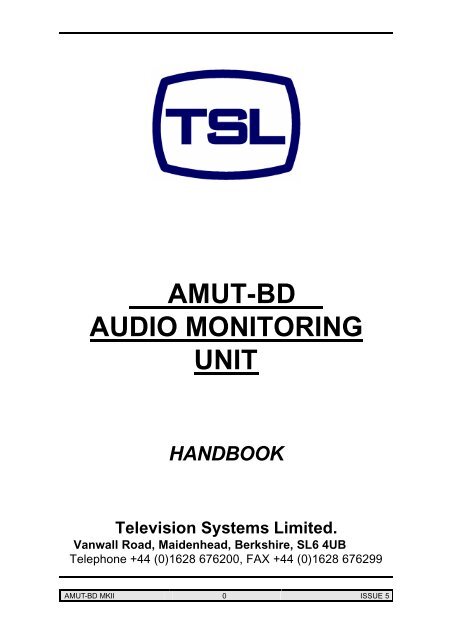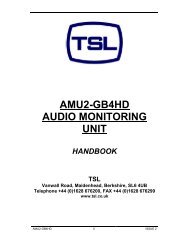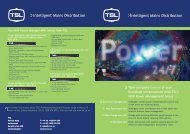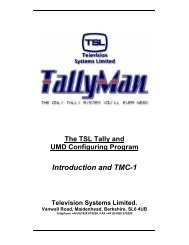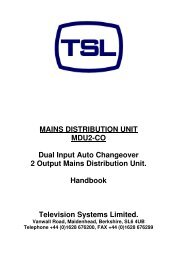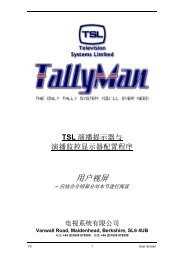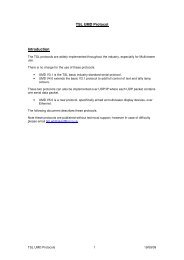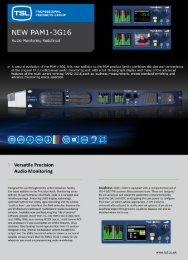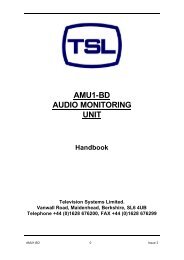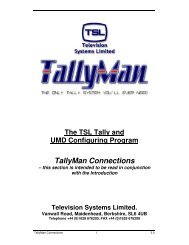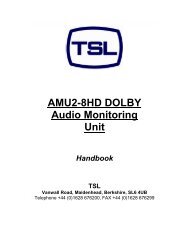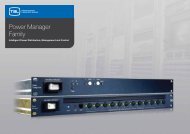AMUT-BD AUDIO MONITORING UNIT - TSL
AMUT-BD AUDIO MONITORING UNIT - TSL
AMUT-BD AUDIO MONITORING UNIT - TSL
Create successful ePaper yourself
Turn your PDF publications into a flip-book with our unique Google optimized e-Paper software.
<strong>AMUT</strong>-<strong>BD</strong><br />
<strong>AUDIO</strong> <strong>MONITORING</strong><br />
<strong>UNIT</strong><br />
HANDBOOK<br />
Television Systems Limited.<br />
Vanwall Road, Maidenhead, Berkshire, SL6 4UB<br />
Telephone +44 (0)1628 676200, FAX +44 (0)1628 676299<br />
<strong>AMUT</strong>-<strong>BD</strong> MKII 0 ISSUE 5
<strong>AMUT</strong>-<strong>BD</strong> MKII 1 ISSUE 5
EC DECLARATION OF CONFORMITY<br />
Application of Council Directives Nos:<br />
EC Low Voltage Directive (73/23/EEC)(OJ L76 26.3.73)(LVD).<br />
Amendment: (93/68/EEC) (OJ L220 30.8.93).<br />
Conformity Standards Declared:<br />
EN 60950<br />
EMC Directive: 89/336/EEC, Amended 92/31/EEC.<br />
Conformity Standards Declared:<br />
EN 50081-1: 1992- EMC- Generic Emissions, Part 1.<br />
EN 50082-1: 1997- EMC- Generic Immunity, Part 1.<br />
EN61000-3-2: 1995- Current Harmonic Emissions.<br />
EN61000-3-3: 1995- Voltage Fluctuations & Flicker.<br />
Manufacturer’s Name:<br />
Manufacturer’s Address:<br />
Type of Equipment:<br />
Model No:<br />
Part Number:<br />
Television Systems Ltd<br />
Vanwall Road<br />
Maidenhead<br />
SL6 4UB<br />
England<br />
United Kingdom<br />
Audio Video Monitoring Unit<br />
<strong>AMUT</strong>-<strong>BD</strong> MKII<br />
<strong>TSL</strong>P- <strong>AMUT</strong>-<strong>BD</strong> MKII<br />
Date CE Mark Affixed: 15/11/99<br />
I, the undersigned, declare that the equipment specified above conforms to the<br />
quoted Directives and Standards.<br />
Place: Maidenhead, England<br />
Signature:<br />
Date: Print: R CHAMBERS<br />
Position: PRODUCT MANAGER<br />
<strong>AMUT</strong>-<strong>BD</strong> MKII 2 ISSUE 5
<strong>AMUT</strong>-<strong>BD</strong> MKII 3 ISSUE 5
SAFETY<br />
Installation.<br />
Unless otherwise stated <strong>TSL</strong> equipment may be installed at any angle or position<br />
within an operating temperature range of 5? - 30? C .<br />
All <strong>TSL</strong> equipment conforms to the EC Low Voltage Directive:<br />
EC Low Voltage Directive (73/23/EEC)(OJ L76 26.3.73)(LVD).<br />
Amendment: (93/68/EEC) (OJ L220 30.8.93).<br />
In all cases, the frame of the equipment must be earthed on installation.<br />
The earth pin on the IEC mains inlet connector is connected to the metal frame of the<br />
equipment, to 0 volts on the internal DC PSU and to signal ground, unless otherwise<br />
stated. All metal panels are bonded together.<br />
Due consideration for cooling requirements must be given when mounting the<br />
equipment. Ideally 1RU of rack space should be left above and below the unit.<br />
Check that the fuse rating is correct for the local power(mains) supply. Replacement<br />
fuses must be of the same rating and type for continued protection against fire risk.<br />
Do not switch on until all connections are made.<br />
WARRANTY, MAINTENANCE AND REPAIR<br />
All <strong>TSL</strong> equipment is guaranteed for one year from the date of delivery to the<br />
customer’s premises. If the equipment is to be stored for a significant period, please<br />
contact <strong>TSL</strong> concerning a possible extended warranty period.<br />
Failure during warranty<br />
If any <strong>TSL</strong> product should fail or become faulty within the warranty period, first please<br />
check the PSU fuses.<br />
All maintenance work must be carried out by trained and competent personnel.<br />
Technical support information<br />
E-Mail address: support@televisionsystems.ltd.uk<br />
Telephone Support Number for the UK and Europe: +44 (0) 1628 670000<br />
Telephone Support Number for the USA only: 1 877 591 2108<br />
<strong>AMUT</strong>-<strong>BD</strong> MKII 4 ISSUE 5
<strong>TSL</strong> Returns Procedure<br />
Please telephone +44 (0)1628 676200 (Fax: +44 (0)1682 676299) and ask for<br />
Sales who will provide a Returns Number. This will enable us to track the unit<br />
effectively and will provide some information prior to the unit arriving.<br />
For each item, this unique Returns Number must be included with the Fault Report<br />
sent with the unit.<br />
A contact name and telephone number are also required with the Fault Report sent<br />
with the unit.<br />
Fault report details required.<br />
? Company:<br />
? Name:<br />
? Address:<br />
? Contact Name:<br />
? Telephone No:<br />
? Returns Number:<br />
? Symptoms of the fault (to include switch setting positions, input signals etc):<br />
Packing<br />
Please ensure that the unit is well packed as all mechanical damage is chargeable.<br />
<strong>TSL</strong> recommends that you insure your equipment for transit damage.<br />
The original packaging, when available, should always be used when returning<br />
equipment..<br />
If returned equipment is received in a damaged condition, the damage<br />
should be reported both to <strong>TSL</strong> and the carrier immediately.<br />
YEAR 2000 CONFORMITY REQUIREMENTS<br />
This product conforms to the following rules:<br />
Rule 1<br />
Rule 2<br />
Rule 3<br />
Rule 4<br />
No value for the current date will cause any interruption in operation.<br />
Date based functionality will behave consistently for dates prior to, during<br />
and after the Year 2000.<br />
In all interfaces and data storage, the century in any date is specified either<br />
explicitly or by unambiguous algorithms or by inferencing rules.<br />
The Year 2000 is recognised as a leap year.<br />
<strong>AMUT</strong>-<strong>BD</strong> MKII 5 ISSUE 5
Contents<br />
1.0 Introduction<br />
2.0 Front Panel Controls<br />
2.1 Input and Meter Selection Buttons<br />
2.2 Bargraph set up<br />
2.3 Output Switching<br />
3.0 AMP-2 Facilities<br />
4.0 Pin-out Details<br />
4.1 Analogue XLR Connectors<br />
4.2 AES/EBU XLR Connectors<br />
4.3 Audio Input/Output Connector – D37 Socket Pinout<br />
4.4 Control Connector - D9 Socket<br />
4.5 External Connector - D15 Plug<br />
5.0 LS Output<br />
6.0 The demultiplexing card – ADX1-1C<br />
6.1 Power<br />
6.2 INPUTS<br />
6.2.1 SDV in<br />
6.2.2 AES in<br />
6.3 Card Edge Controls<br />
6.4 Outputs<br />
6.4.1 Composite Video output<br />
6.4.2 AES outputs<br />
6.4.3 Analogue Audio outputs<br />
6.5. Description of facilities<br />
6.5.1 De-embedding Algorithms<br />
6.5.2 Front panel piano switch<br />
6.6 Pinout details<br />
6.7 Notes<br />
7.0 AMU Alignment Procedure<br />
7.1 Initial Set-Up<br />
7.2 Audio Alignment AMP-2<br />
7.3 Bargraph Calibration<br />
8.0 General Notes<br />
9.0 Specification<br />
<strong>AMUT</strong>-<strong>BD</strong> MKII 6 ISSUE 5
1.0 Introduction<br />
<strong>AMUT</strong>-<strong>BD</strong> MKII <strong>AUDIO</strong> <strong>MONITORING</strong> <strong>UNIT</strong><br />
The <strong>AMUT</strong>-<strong>BD</strong> MKII is a half rack 3RU x 400mm deep Audio Monitoring Unit with a<br />
<strong>TSL</strong> Bargraph.<br />
The following features are standard:<br />
? Six switch selectable stereo analogue inputs.<br />
? Two AES/EBU inputs.<br />
? One SDV input.<br />
? Audio-present indication.<br />
? Phase reverse switch.<br />
? Out-of-phase error indication.<br />
? M and S PPM Switching.<br />
? Decoded PAL/NTSC composite or re-clocked SDV output.<br />
? Optional additive output switch selection.<br />
? Two x 30 Watt RMS into 4 ? loudspeaker amplifiers.<br />
? Headphone outputs with LS muting.<br />
? Fixed and variable stereo line outputs.<br />
<strong>AMUT</strong>-<strong>BD</strong> MKII 7 ISSUE 5
2.0 Front Panel Controls<br />
2.1 Input and Meter Selection Buttons<br />
1 – 4 Analogue I/Ps. A1 (Left Channel) is fed to the top<br />
bargraph and A2 (Right Channel) is fed to the bottom<br />
bargraph.<br />
5 & 6 To select of channel 5 press phase rev. button with input<br />
3, this lights the input 2&3 LEDs together.To select<br />
channel 6 press phase rev. button with input 4, this lights<br />
the input 2 & 4 LEDs together.<br />
AES1/2<br />
SDV<br />
M/S<br />
Selects one of two AES signals to the bargraph.<br />
Selects A1/A2 or A3/A4 from the de-embedded SDV to<br />
the bargraph.<br />
Displays the MIX (mono) signal on the upper bargraph<br />
and the SEPARATION (difference) on the lower bargraph<br />
of the selected Input.<br />
Ø Rev Momentary phase reverse between A1 and A2.<br />
<strong>AMUT</strong>-<strong>BD</strong> MKII 8 ISSUE 5
2.2 Bargraph set-up Menu<br />
<strong>TSL</strong> Bargraph<br />
These are accessed via the select & change buttons located between the two<br />
alphanumeric displays to the left of the unit (see diagram above). The top display<br />
shows the function & the bottom gives the state.<br />
1) Pressing select once gives:<br />
P E A K<br />
H D 0<br />
The zero toggles between 0 , 1 and 2 when the change button is pressed. 0 is<br />
off, and 1 is on and the highest level point is displayed. HD 2 operates only in<br />
the PPM mode and displays the level numerically with the reference marker.<br />
With HD 0 selected the alphanumeric display is off.<br />
2) Pressing select a second time gives:<br />
D I S P<br />
B A R<br />
All the LEDs are lit up to the highest level displayed.<br />
Pressing the change button gives:<br />
D I S P<br />
D O T<br />
Only the highest level LED is lit.<br />
<strong>AMUT</strong>-<strong>BD</strong> MKII 9 ISSUE 5
3) Pressing select a third time gives:<br />
R S P N<br />
1ms<br />
Pressing the change button gives:<br />
0.1ms<br />
This changes the response for the relevant scales. (10mA,VU,<br />
10mB)<br />
4) Pressing select a fourth time gives:<br />
I D 0<br />
O N<br />
This enables the unit to display the reference markers which are nominally<br />
set to 0dB. These are set as follows for the appropriate scales fitted: PPM 4<br />
for UK, TEST for EBU, - 4 for VU, - 6 for DIN, 0 or Test for Nordic, -18dB or -<br />
20 dB for Digital.<br />
When the change button is depressed the markers are not displayed and an<br />
OFF indication is displayed in the lower display.<br />
5) Pressing select for a fifth time gives:<br />
B R G T<br />
Depressing the change button changes the brightness or intensity of the<br />
display. Successive presses decrease brightness.<br />
6) Pressing select for a sixth time gives:<br />
I / P :<br />
A n l g<br />
Depressing the change button changes the input from Analogue to digital<br />
(AES)<br />
<strong>AMUT</strong>-<strong>BD</strong> MKII 10 ISSUE 5
7) Pressing select for a seventh time gives:<br />
S C L E<br />
E B U<br />
Depressing the change button defines which scale is in use. (EBU, ABC,<br />
DIN, PPM, Nordic, ABC or VU.)<br />
8) Pressing select for a eighth time gives:<br />
0 R E F<br />
- 1 8<br />
Depressing the change button selects the digital reference. (-18, -20 or –24)<br />
9) Pressing select for a ninth time gives<br />
L O U D<br />
O N<br />
Depressing the change button turns the loudness indication on or off.<br />
2.2 Output Switching<br />
A1/A2<br />
A3/A4<br />
DIM<br />
These buttons select either:<br />
- the Analogue Left or Right signals of the metered Input,<br />
- the AES/EBU Input 1 Left or Right signals or<br />
- the selected SDV group A1 & A2 decoded outputs to<br />
the Left or Right Output Channels.<br />
The buttons toggle. Additive mixing is possible if two or<br />
more buttons are selected together.<br />
These buttons select either:<br />
- Analogue Left or Right I/P 8 signals,<br />
- the AES/EBU Left or Right signals of Input 2 or,<br />
- the selected SDV group A3 & A4 decoded outputs to<br />
the Left or Right Output Channels.<br />
The buttons toggle. Additive mixing is possible if two or<br />
more buttons are selected together.<br />
Approximately 16dB of attenuation is switched into the<br />
audio path<br />
<strong>AMUT</strong>-<strong>BD</strong> MKII 11 ISSUE 5
CUT/MUTE<br />
VOLUME<br />
The front panel button CUT(s) the signal to all O/Ps.<br />
Remote Mute of either or both of the LS O/Ps and<br />
Variable Line O/Ps are possible via a rear connector. A<br />
ground is required on the appropriate pin to activate the<br />
MUTE condition.<br />
The Headphones O/P and the Variable Line O/P may be<br />
varied.<br />
3.0 AMP-2 Facilities<br />
This card provides all of the analogue processing.<br />
<strong>AMUT</strong>-<strong>BD</strong> MKII 12 ISSUE 5
4.0 Pin-out Details<br />
4.1 Analogue XLR Connectors<br />
XLRS PIN FUNCTION<br />
ANALOG 1 1 GND<br />
ANALOG 1 2 1 IN+<br />
ANALOG 1 3 1 IN-<br />
ANALOG 2 1 GND<br />
ANALOG 2 2 2 IN+<br />
ANALOG 2 3 2 IN-<br />
<strong>AMUT</strong>-<strong>BD</strong> MKII 13 ISSUE 5
4.2 AES/EBU XLR Connectors<br />
XLRS PIN AES FUNCTION<br />
AES 1 1 AES GND<br />
AES 1 2 AES 1 IN+<br />
AES 1 3 AES 1 IN-<br />
AES 2 1 AES GND<br />
AES 2 2 AES 2 IN+<br />
AES 2 3 AES 2 IN-<br />
4.3 Audio Input/Output Connector – D37 Socket Pinouts<br />
D 37 SOCKET <strong>AUDIO</strong> FUNCTION D 37 SOCKET <strong>AUDIO</strong> FUNCTION<br />
ON AMU INPUTS<br />
ON AMU OUTPUTS<br />
PIN NO<br />
PIN NO<br />
1 I/P1 A1 + 13<br />
20 I/P1 A1 - 32<br />
2 I/P1 A2 + 14<br />
21 I/P1 A2 - 33<br />
3 I/P2 A1 + 15<br />
22 I/P2 A1 - 34<br />
4 I/P2 A2 + 16<br />
23 I/P2 A2 - 35<br />
5 I/P3 A1 + 17 FIX. O/P A1 +<br />
24 I/P3 A1 - 36 FIX. O/P A1 -<br />
6 I/P3 A2 + 18 FIX. O/P A2 +<br />
25 I/P3 A2 - 37 FIX. O/P A2 -<br />
7 I/P4 A1 + 19 SCREEN<br />
26 I/P4 A1 -<br />
8 I/P4 A2 +<br />
27 I/P4 A2 -<br />
9 I/P5 A1 +<br />
28 I/P5 A1 -<br />
10 I/P5 A2 +<br />
29 I/P5 A2 -<br />
11 I/P6 A1 +<br />
30 I/P6 A1 -<br />
12 I/P6 A2 +<br />
31 I/P6 A2 -<br />
<strong>AMUT</strong>-<strong>BD</strong> MKII 14 ISSUE 5
4.4 Control Connector - D9 Socket<br />
This is wired for RS422.<br />
D9 CONTROL<br />
1 0V<br />
6 0V<br />
2 TX-<br />
7 TX+<br />
3 RX+<br />
8 RX-<br />
4 0V<br />
9 0V<br />
5 N/C<br />
<strong>AMUT</strong>-<strong>BD</strong> MKII 15 ISSUE 5
4.5 External Connector – D15 Plug<br />
D15 EXTERNAL<br />
PIN FUNCTION<br />
1 Mute 1<br />
2 Mute 2<br />
3 GPI-1<br />
4 GPI-2<br />
5 N/C<br />
6 N/C<br />
7 N/C<br />
8 N/C<br />
9 N/C<br />
10 N/C<br />
11 N/C<br />
12 N/C<br />
13 N/C<br />
14 +5V<br />
15 0V<br />
5.0 LS Output - LSA-4/2 card.<br />
The loudspeaker amplifier uses a bridged circuit producing high output power.<br />
Therefore, neither output terminal may be connected to ground.<br />
6.0 The demultiplexing card – ADX-1C<br />
This specification describes the Celtic Audio module ADX-1C Issue 1 loaded with<br />
software A02.<br />
This module has been designed to monitor AES3 digital audio and AES digital<br />
audio embedded in a SMPTE 259M-C video data stream, together with the video<br />
content which is output as either composite or re clocked SDV depending on the<br />
board variant.<br />
6.1 Power<br />
+5V ± 5% @ < 0.5A<br />
+12V ± 5% @ < 150mA<br />
-12V ± 5% @ < 100mA<br />
<strong>AMUT</strong>-<strong>BD</strong> MKII 16 ISSUE 5
6.2 INPUTS<br />
6.2.1 SDV in<br />
Connector Type: DIN 41612 pins<br />
Receiver type:<br />
AC coupled, auto equalising with clock regeneration<br />
Impedance: 75?<br />
Performance: Up to 300m of high quality cable (eg Belden 1694)<br />
Standards:<br />
SMPTE 259M-C with embedded 48kHz audio per<br />
SMPTE 272MA<br />
NB – the performance of this input stage is critically dependent on the cable<br />
termination on the rear connector. Thus it is not possible to guarantee return loss<br />
or cable length performance in anything other than an agreed test jig.<br />
6.2.2 AES in<br />
Connector type:<br />
Impedance:<br />
Input Sensitivity:<br />
Standards:<br />
DIN 41612 pins<br />
75? unbalanced or 110? balanced. Impedance is switch<br />
selected with on-board transformer balancing. To obtain an<br />
unbalanced connection one line of the input needs to be<br />
grounded at an electrically convenient point.<br />
< 200mV pk-pk per AES3<br />
AES3 (1992) at 48kHz, 44.1kHz or 32kHz<br />
6.3 Card Edge Controls<br />
Independent channel gains are provided for each of the four analogue outputs by<br />
means of a multi-turn potentiometer providing ± 6dB adjustment. The nominal line-up<br />
level for the board is designed to be 0dBm out for –20dB FS in.<br />
6.4 Outputs<br />
6.4.1 Composite Video output<br />
Connector Type: DIN41612 pins<br />
Format:<br />
PAL or NTSC according to standard on SDI input.<br />
Impedance: 75?<br />
Amplitude: 1V pk-pk ± 5%<br />
<strong>AMUT</strong>-<strong>BD</strong> MKII 17 ISSUE 5
6.4.2 AES outputs<br />
Connector type:<br />
Impedance:<br />
DIN41612 pins<br />
75? unbalanced or 110? balanced. Impedance is switch<br />
selected with on-board transformer balancing. To obtain an<br />
unbalanced connection one line of the output needs to be<br />
grounded at an electrically convenient point.<br />
Amplitude: 1V (75 or 2V (110? )<br />
6.4.3 Analogue Audio outputs<br />
Connector Type:<br />
Format:<br />
D/A Conversion:<br />
THD+N:<br />
DIN 41612 pins<br />
Electronically balanced.<br />
24 bit resolution.<br />
>90dB referred to 0dBFS<br />
There are a total of four audio signal outputs, which represent the two channels of two<br />
AES pairs.<br />
6.5. Description of facilities<br />
6.5.1 De-embedding Algorithms<br />
The board provides for the extraction of a four channel audio group as defined by<br />
SMPTE 272M. The clock recovery system mandates that the incoming audio must<br />
be synchronous 48kHz data for proper reproduction, although addition and deletion<br />
of samples is used to overcome minor asynchronism. No guarantee can be given for<br />
audio quality under these conditions.<br />
In the event that one channel pair is absent from the incoming group, the appropriate<br />
pair will be muted.<br />
<strong>AMUT</strong>-<strong>BD</strong> MKII 18 ISSUE 5
6.5.2 Card edge piano switch<br />
Down is ON.<br />
Levers S1, S2:<br />
These select the default SDV embedded audio group at power-up.<br />
S1 S2 GROUP SELECTED<br />
OFF OFF 1<br />
ON OFF 2<br />
OFF ON 3<br />
ON ON 4<br />
Lever S3: AES / Embedded<br />
If set to ON, AES input will be selected. Overrides SDV group select.<br />
Lever 4: Not defined.<br />
Lever 5: PAL-M selection<br />
If set ON, this will cause the encoded output to generate PAL-M format when 525 line<br />
SDI exists on the video input.<br />
Lever 6: AES Termination<br />
If set ON, this will select a 75? interface on all the AES input and outputs. Default is<br />
110? .<br />
Lever 7: Reserved for I 2 C address select bit 0<br />
Lever 8: Reserved for I 2 C address select bit 1<br />
<strong>AMUT</strong>-<strong>BD</strong> MKII 19 ISSUE 5
6.6 Pinout details<br />
The following is the pin description for ADX-1<br />
------ indicates not used<br />
Pin ADX-1 Pin ADX-1<br />
1a SDI Gnd 1b SDI Gnd<br />
2a SDI in 2b SDI Gnd<br />
3a SDI Gnd 3b SDI Gnd<br />
4a Composite out 4b DGnd<br />
5a DGnd 5b DGnd<br />
6a AES 1+ in 6b AES 1- in<br />
7a DGnd 7b DGnd<br />
8a AES 2+ in 8b AES 2- in<br />
9a DGnd 9b DGnd<br />
10a AES 1+ out 10b AES 1- out<br />
11a AES 2+ out 11b AES 2- out<br />
12a DGnd 12b DGnd<br />
13a Control In 1 13b Control in 2<br />
14a Control In 3 14b Control In 4<br />
15a Control In 5 15b Control In 6<br />
16a Control Out 1 16b Control Out 2<br />
17a Control Out 3 17b Control Out 4<br />
18a Control Out 5 18b Control Out 6<br />
19a Control Out 7 19b Control Out 8<br />
20a Control Out 9 20b Control Out 10<br />
21a Control Out 11 21b Control Out 12<br />
22a Control Out 13 22b Control Out 14<br />
23a AGnd 23b AGnd<br />
24a Analogue L1+ 24b Analogue L1-<br />
25a Analogue R1+ 25b Analogue R1-<br />
26a Analogue L2+ 26b Analogue L2-<br />
27a Analogue R2+ 27b Analogue R2-<br />
28a ------ 28b ------<br />
29a +5V 29b +5V<br />
30a -12V 30b -12V<br />
31a +12V 31b +12V<br />
32a 0V 32b 0V<br />
<strong>AMUT</strong>-<strong>BD</strong> MKII 20 ISSUE 5
6.7 Notes<br />
Output analogue levels are adjustable over the following range:<br />
0 dBm = 0.775V into 600? i.e. 1mW power dissipation.<br />
0 dBu = 0.775V rms = PPM 4.<br />
Nominally, -18 dB ref 0FS = 0 dBu output.<br />
European line up :<br />
American line:<br />
-18 dBu<br />
-20 dBu<br />
Adjustment of ± 6 dB about the –20 dBfs line up level is possible.<br />
This procedure assumes that the user is familiar with precision audio equipment<br />
alignment. All model variants are covered here so the user will understand the<br />
function of the various controls.<br />
It is recommended that an exchange card is obtained from <strong>TSL</strong> in the event of a fault.<br />
Due to the complexity of these circuit cards <strong>TSL</strong> use a custom jig for accurate<br />
alignment<br />
7.0 AMU Alignment Procedure<br />
This procedure assumes that the user is familiar with precision audio equipment<br />
alignment. All model variants are covered here so the user will understand the<br />
function of the various controls.<br />
It is recommended that an exchange card is obtained from <strong>TSL</strong> in the event of a fault.<br />
Due to the complexity of these circuit cards <strong>TSL</strong> use a custom jig for accurate<br />
alignment<br />
<strong>AMUT</strong>-<strong>BD</strong> MKII 21 ISSUE 5
7.1 Initial Set-Up<br />
Connect 1khz Tone @ 0dB to Analogue I/P 1 L & R.<br />
Set front panel switches to Analogue I/P 1 , check for audio presence indication on<br />
front panel LEDs and deflection on both meters .<br />
7.2 Audio Alignment AMP-2<br />
The board is set for unity gain.<br />
Place the AMP-2 PCB on an extender card.<br />
PR1 is set for the LH A1 channel 0dB O/P probe pins C10/C11- balanced.<br />
PR2 is set for the RH A2 channel 0dB O/P probe pins C12/C13 – balanced.<br />
PR5 is set for 0db for the fixed A3 channel probe pins C14/C15 – balanced.<br />
PR6 is set for 0dB for the fixed A4 channel probe pins C16/C17 – balanced.<br />
PR3 is set for 0dB for the S signal probe pin C1.<br />
PR4 is set for 0dB for the M signal probe pin C1.<br />
PR7 is the LH PPM drive output and is set for 0dB probe pin C24.<br />
PR8 is the RH PPM drive signal and is set for 0dB probe pin C25.<br />
7.3 Bargraph Calibration Procedure<br />
Factory Setting.<br />
8.0 General Notes<br />
1. Set the ADX-1 card for the desired reference level with AES/EBU<br />
and/or SDV I/P signals.<br />
2. Please note that some American equipment has the function of the<br />
XLR pins 2 & 3 reversed.<br />
<strong>TSL</strong> product is wired to the European standard<br />
<strong>AMUT</strong>-<strong>BD</strong> MKII 22 ISSUE 5
9.0 <strong>AMUT</strong>-<strong>BD</strong> MKII Technical Specifications<br />
Power Supply<br />
Supply Voltage 90 -250V AC @ 50Hz/60Hz +/- 10%<br />
Power Consumption<br />
150 VA Max.<br />
Physical Dimensions<br />
Height<br />
Width<br />
Depth<br />
Weight<br />
Inputs 1 & 2<br />
Connector Type<br />
Signal<br />
Frequency Response<br />
Impedance<br />
133mm (3RU)<br />
Half width<br />
404mm<br />
5250gm<br />
XLR Female 3 pin. Pin 1 Gnd, Pin 2 hot, Pin 3 cold.<br />
Balanced line level audio.<br />
30Hz to 25kHz<br />
>20k?<br />
Inputs 1 - 6<br />
Connector Type D37.<br />
XLR Inputs 1, 2 & 3. in parallel<br />
Signal<br />
Balanced line level audio.<br />
Frequency Response 30Hz to 25kHz ±1dB<br />
Impedance<br />
>20k?<br />
Inputs AES 1,AES2<br />
ConnectorType<br />
Standard<br />
Impedance<br />
Input, SDV<br />
Connector Type<br />
Standard<br />
Impedance<br />
XLR Female 3 pin. Pin 1 Gnd,Pin 2 hot, Pin 3 cold.<br />
AES3 (1994) at 48kHz, 44.1kHz or 32kHz<br />
75 ohm unbalanced or 110 ohm – balanced.<br />
BNC.<br />
SMPTE 259M 4:2:2 component 525/60 or 625/50 with<br />
Embedded 48kHz audio.<br />
75ohm<br />
Line Output.<br />
Connector<br />
XLR 3 pin Male<br />
Impedance 50?<br />
Output Levels<br />
Through level control with 0dB gain.<br />
Fixed Line O/P<br />
Available on D37 connector<br />
Headphone Output.<br />
Connector<br />
Stereo Jack socket type A<br />
Impedance 50?<br />
Output Levels<br />
Through level control with 0dB gain.<br />
Loudspeaker Outputs.<br />
Connectors<br />
4mm Binding Posts<br />
Output rating Max 30W RMS /Ch into 4? ,<br />
Loudness algorithm Based on ISO 226<br />
<strong>AMUT</strong>-<strong>BD</strong> MKII 23 ISSUE 5


